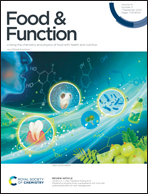Dangshen Huangjiu prevents gastric mucosal injury and inhibits Akt/NF-κB pathway†
Abstract
One of the top ten tonic herbs, Dangshen is frequently found in Chinese functional foods. With the inclusion of Dangshen in the list of food and medicine substances in 2020, the Dangshen Huangjiu (DHJ) emerged. In the Bencao, it is written that Huangjiu can “open up the curved veins and thicken the stomach and intestines”. Furthermore, increasing investigations have verified the protective effect of Dangshen on the gastric mucosa. Therefore, we propose the hypothesis that the stomach mucosa might be protected by the DHJ. To demonstrate that the effect of solids in Dangshen Huangjiu (DHJG) on damaged human gastric mucosal epithelial cells (GES-1) was reversed, the study used ethanol to induce injury to GES-1 and then used protein immunoblotting (western blotting) to determine the expression levels of p-Akt, p-NF-κB-p65, and NF-κB-p65 proteins in the cells. 0.04 mol L−1 MNNG (5 mL kg−1 body weight) mixed with eating disorders(2 d satiety, l d starvation, 3 d cycle) was used to further establish a chronic non-atrophic gastritis (CNAG) model in Wistar rats, at the same time, the experimental rats were given DHJ and DHJG gavage. Cellular assays confirmed that DHJG (25–100 μg mL−1) dose-dependently increased the viability of ethanol-injured GES-1 and lowered p-Akt and p-NF-κB-p65/NF-κB-p65 protein expression. Animal experiments revealed that 10 mL kg−1 and 20 mL kg−1 DHJ had no significant effect on the basic activity and gastric tissues and related biochemical indices of healthy rats; DHJ (10 mL kg−1, 20 mL kg−1) and DHJG (2.8 g kg−1, 11.4 g kg−1) resulted in some improvement in weight loss and significant improvement in gastric mucosal pathology in CNAG rats with damage. Particularly, DHJ and DHJG significantly decreased the expression of p-Akt, p-NF-κB-p65/NF-κB-p65 and Bcl-2/Bax proteins and Akt, IKKβ, IκBα and NF-κB mRNA in the gastric tissues of CNAG rats. These results showed that DHJG ameliorates ethanol-induced GES-1 cell injury; both DHJ and DHJG alleviate CNAG, and the mechanisms by which they do so may be related to DHJ and DHJG increasing the antioxidant capacity (elevating SOD, decreasing MDA), attenuating inflammatory responses (decreasing IL-1β, IL-6, and TNF-α), reversing apoptosis (reducing the Bcl-2/Bax ratio) and down-regulating gastric tissue p-Akt and p-NF-κB-p65/NF-κB-p65 protein expression as well as Akt, IKKβ, IκBα and NF-κB mRNA expression. This study indicates that the interventional effects of DHJ and DHJG in CNAG may act through the Akt/NF-κB signaling pathway.



 Please wait while we load your content...
Please wait while we load your content...